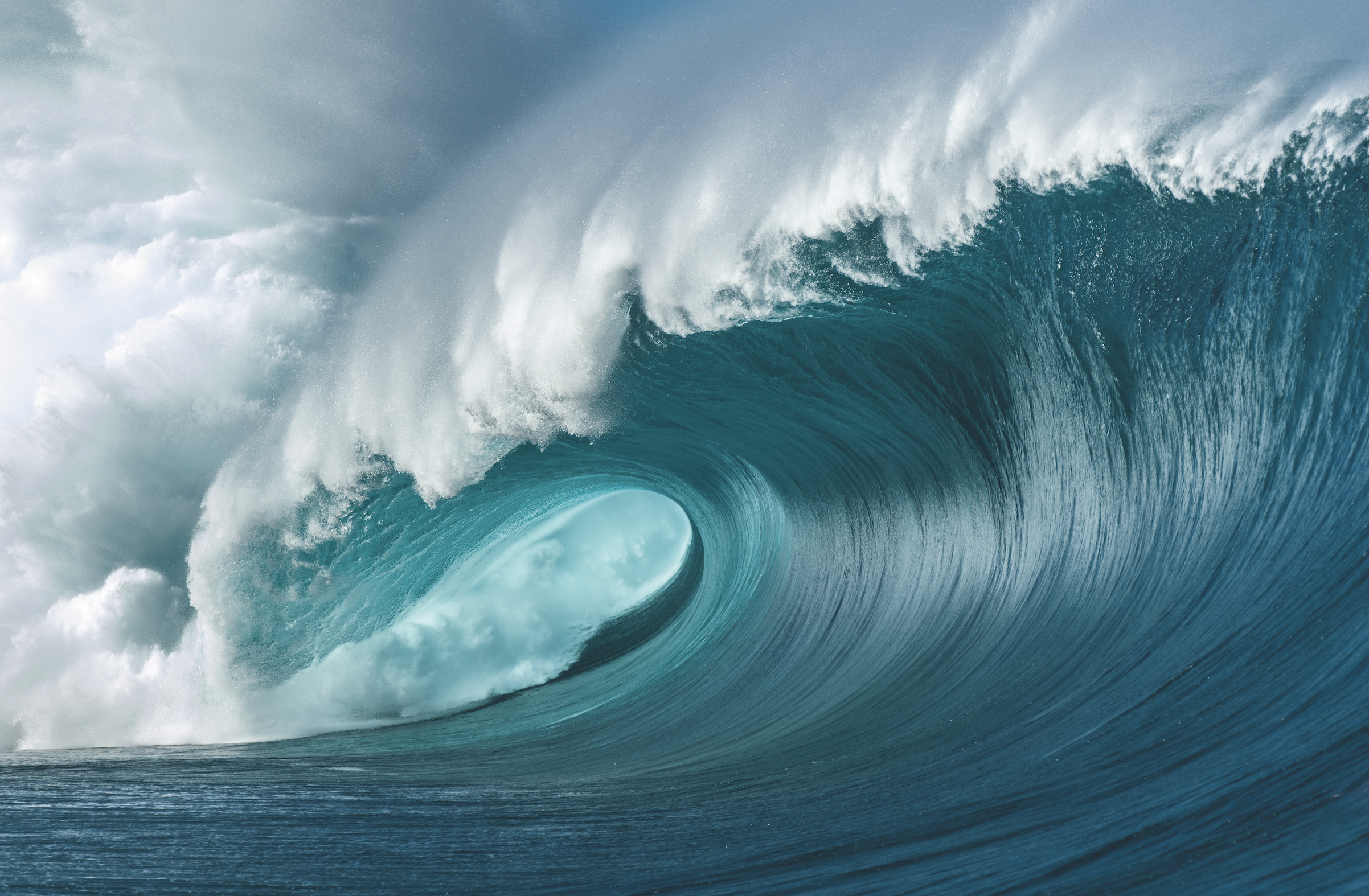
Audemars Piguet’s Slew Of New Royal Oak Watches
The new collections celebrate the model’s 50th anniversary.
Related articles
It’s going to be a massive year for Audemars Piguet as it rolls out the red carpet for its legendary Royal Oak collection, which is celebrating its 50th anniversary. The Gérald Genta-designed watch, first released in 1972, has become so iconic for the brand that some would argue it is the brand despite recent attempts to create new collections like Code 11.59. The Royal Oak is hotter than ever and Audemars Piguet CEO François-Henri Bennahmias has big plans to keep it that way. At a digital press conference on Tuesday to reveal the much anticipated 2022 Royal Oak models, the head honcho not only dropped new and improved watches but also a few rather interesting tidbits that chart the company’s plans for the future.
So, before we jump in with the big news about the “Jumbo” Ref. 16202, here are a few highlights from both Bennahmias and Michael Friedman, Audemars Piguet’s head of complications:
- In 2021, the company sold 45,000 watches and raked in a revenue of almost $1.6 billion. The company has 2,500 employees. In 2022, AP will up its output to 50,000 timepieces.
- But the bigger headline is that the company plans to set aside a “big chunk” of Royal Oaks for newcomers to the brand. So, how do first-timers distinguish themselves from the pack to land a piece from this allotment? “The right way to do it is actually very simple: create and develop a relationship with us,” says Bennahmias, making it sound laughably simple. “When you don’t know anyone you have to get known by our people and, eventually things happen.”

Audemars Piguet Royal Oak “Jumbo” Extra-Thin Ref. 16202 50th Anniversary Caseback Audemars Piguet
- All of the Royal Oak models for 2022, with the exception of existing perpetual calendars, will come with a special oscillating mass, visible through the caseback with a cut-out that says “50 Years.” After December 31, 2022, the models will come with a standard oscillating mass.
- Royal Oak Concept watches will be launched later in 2022, but 2023 is when the company says it will launch something “very, very new in the concept case.”
- Future research and development will be focused on ergonomics, or making the watches more comfortable on the wrist, notably with a potential focus on thinness. ” We have to simplify and we have to amplify the readability on the watches and the ergonomy on the wrist and the way it feels and the way it is balanced,” says Bennahmias. “All of our work will be done in that direction, which will lead us to new mechanisms, thinner ones, potentially, we’ll see, and especially materials.” That could mean that AP has plans to seriously compete in the ongoing ultra-thin race with Bulgari and Piaget.
- “Little touchpoints [have been updated] throughout the pieces and little elements,” says Friedman. But [with the intention of] never ever touching the integrity of the original design. It’s had small evolutions over the last 50 years, small touches are what we’ve done to put attention on the men and women that create them and how it feels and looks on the wrist.”
If it’s not broke, don’t fix it! So, what you will see here mostly looks like the Royal Oaks you have seen before except with small design tweaks, save for the Ref. 16202 below. And for those looking to begin a relationship with Audemars Piguet, here’s a pro tip: Bennahmias says he is flying out today to head to New York and then Los Angeles to make sure “allocations are done the right way,” which means if you can spot him in a boutique, you can start your campaign for a Royal Oak from the top.
Royal Oak “Jumbo” Extra-Thin Ref. 16202

Audemars Piguet Royal Oak “Jumbo” Extra-Thin Ref. 16202 Audemars Piguet
The Royal Oak Ref. 15202 is replaced by the new Ref. 16202. The next-gen 39mm “Jumbo” Extra-Thin now houses a new self-winding extra-thin Calibre 7121. It is the first time since 1972, that this model has a new self-winding hour, minute and date movement, replacing the Calibre 2121. At its debut, the retired movement was the thinnest automatic movement (3.05mm) with central rotor and date indication. The new iteration is slightly larger, measuring 3.2 mm, and is newly equipped with a rapid date-corrector. It now has a larger barrel with more power for more precise timekeeping over a longer period of time in 55 hours of power reserve. Five years in development, it now has bidirectional winding, a balance wheel fit with inertia blocks to avoid unnecessary friction and comes with a patented extra-thin low-energy date-setting mechanism. Plus, it has been finished to high-horology standards with Côtes de Genève, Traits Tirés and circular graining finishes visible through the caseback.
There are four models in stainless steel, 18-carat pink gold, yellow gold and platinum. Two new smoked Petite Tapisserie dials have been added in the pink-gold and yellow-gold models. They are both achieved through a galvanic bath process and involve spraying colored varnish on the rotating dial’s periphery. The pink-gold version has contrasting smoked gray hues, while the yellow-gold dial comes in striking smoked yellow-gold tones. The platinum version will be exclusively sold through the company’s AP Houses.
Price: Stainless steel, approx. $46,640 ; 18-carat pink gold, approx. $99,000 ; yellow gold, approx. $99,000; platinum, upon request
Royal Oak “Jumbo” Extra-Thin Openworked Ref. 16204

Audemars Piguet Royal Oak “Jumbo” Extra-Thin Openworked Ref. 16204 Diode SA – Denis Hayoun
Also sporting a calibre, is the 39 mm “Jumbo” Extra-Thin Openworked Ref. 16204 available in stainless steel or 18-carat pink gold. It houses the new selfwinding extra-thin openworked movement, Calibre 7124, a derivative of the Calibre 7121 above. Measuring just 2.7 mm, as opposed to its Calibre 5122 predecessor at 3.05 mm, it is similar to the 7121 but has an openworked architecture with the mainplate and bridge cut via CNC machining before being perfected by electric discharge machining, which allows the company to remove material with extreme precision to achieve its cut-out look. There are 324 hand-polished V angles that can be viewed on the dial and caseback.
The case and bracelet on both models have are stain-brushed and polished in an alternating fashion right down to the folding clasp. The openworked dial of the pink-gold model comes with slate grey bridges and a contrasting light grey barrel at 11 o’clock, while the stainless-steel version has a rhodium-toned movement.
Price: Stainless steel, approx. $127,000; 18-carat pink gold, upon request
Royal Oak 34mm Selfwinding Black Ceramic

Audemars Piguet Royal Oak 34mm Selfwinding Black Ceramic Audemars Piguet
You might think you are looking at the same black ceramic Royal Oak that was released just last year, but the company has already given it a facelift. Notice the brand logo has been spelled out on the new model, replacing the “AP” on the original (see below). The signature is now crafted in 24-carat pink gold and realized through a chemical process similar to 3D printing. The letters are connected with links the size of a hair and placed on the dial by hand with tiny legs, invisible to the eye, to secure them in place. The numerals in the date window have been changed to gold instead of white, the pins that connect the links in the bracelet are no longer visible on the side but directly fit into the studs and the size and length of the hour markers have been adjusted for better visibility.
The details are incredibly subtle, but they do make a difference. And that may ruffle the feathers of clients who already jumped to get their hands on this ultra-hot model.

Audemars Piguet Royal Oak Selfwinding 34 mm Audemars Piguet
Price: approx. $69,700
Royal Oak Selfwinding Flying Tourbillon

Audemars Piguet Royal Oak Selfwinding Flying Tourbillon Audemars Piguet
Three new 41mm Royal Oak Selfwinding Flying tourbillons, in 18-carat pink gold, stainless steel and titanium, following models in this reference that were introduced last year. They feature the same Caliber 2950 movement combining a flying tourbillon with a central rotor, but the latest iterations now come with cases and bracelets with wider bevels with the first links decreased in thickness for an easier wear on the wrist. The caseback has also been slightly embedded in the case middle to also offer a more comfortable fit.
On the dial side, the dimensions of the hour markers and hands have been improved and the Audemars Piguet signature, like the black ceramic model, has been applied in 24-carat gold. New tones have been added to the Grande Tapisserie dial, executed in a traditionally horizontal fashion versus the sunray arrangement of previous models, in smoked blue to compliment the stainless-steel and 18-carat pink-gold models, while the titanium reference stands apart in a straight sandblasted blue hue without the traditional
motif. The latter also has a white circle to highlight the minute track.

Audemars Piguet Royal Oak Selfwinding Flying Tourbillon Caseback Audemars Piguet
Finally, the Côtes de Genève finishing on the movement, visible through the caseback, has been ever so slightly tweaked to be crafted horizontally instead of in a sunray pattern to mimic the linear Tapisserie motif on the dial.
Price: Upon request
Royal Oak Flying Tourbillon Openworked

Audemars Piguet Royal Oak Flying Tourbillon Openworked Audemars Piguet
The pièce de résistance in the 50th-anniversary collection is the 41mm openworked version of the Flying Tourbillon. The calibre 2950 was only just introduced, and yet we are already seeing an openworked version. “The new Selfwinding Tourbillon Openworked—the architecture of this movement is unlike anything I’ve seen before, we’ve seen before and unlike anything we’ve created before,” says Friedman. “The bridges have been finished both vertically and horizontally, creating a beautiful 3D effect.” Audemars Piguet launched an openworked tourbillon for its 40th anniversary in 2012, so the company felt it needed to up the ante for the Royal Oak’s half-a-century milestone. “It’s very much openworking for the 21st century,” says Friedman. “I’m blown away by the watch. The watch collector in me, the fan boy in me, I just salivate when I look at that watch.”
So, how many will be produced? Bennahmias says they will make just 125 pieces this year and will follow with 80 pieces in 2023 and 45 in 2024. This year’s models, of course, will come with the 50th-anniversary rotor. Either way, very few clients will get their hands on one.
Price: Upon Request
Audemars Piguet Royal Oak and Royal Oak Selfwinding Chronograph Watches

Audemars Piguet Royal Oak and Royal Oak Selfwinding Chronograph Watches Audemars Piguet
There are 28 variations on standard 37 mm Royal Oaks and 38 and 41mm Royal Oak Selfwinding Chronographs combined. Additional models in 41 and 34 mm will be available in the second half of 2022. Here is what’s new: bevels on the top and bottom have been enlarged, the caseback has been slightly integrated into the case middle for a better wear, the integrated bracelet’s first four links are not trapezoidal-shaped instead of parallel, links are thinner and lighter (this was already introduced on gold references a few years ago but now applies to stainless-steel and titanium pieces), the minute track is now printed directly onto the Tapisserie dial and like other models the hour markers and hands are refined according to different dial diameters and the AP logo is replaced by a printed “Audemars Piguet” at 12 o’clock.
And while the dial colors come in everything from forest green to light gray, the collection now includes a night blue color or “Blue Nuit” and a baby blue dubbed Cloud 50 or “Nuage 50” in Petite Tapisserie or Grande Tapisserie patterns.
Royal Oak Offshore 43mm Diamond Pavé

Audemars Piguet Royal Oak Offshore 43 mm Diamond Pavé Watches Audemars Piguet
The Royal Oak Offshore, having been introduced only 30 years ago, is not celebrating a Jubilee – so no special rotor design – but it is getting dressed up in its older brother’s honor. Audemars introduced four new diamond-set models, two of them slathered in round brilliant diamonds that cover the dial, case and, in one model, the bracelet (5.83 carats and 12.53 carats, respectively). The other two have baguette diamonds set into the bezel and case or just the bezel (10.78 carats and 1.45 carats, respectively). All models contain Audemars Piguet’s first integrated chronograph calibre, the 4401, which debuted last year. The diamonds are dramatically juxtaposed next to black coloured chronograph subdials on the round-brilliant versions, lending a brilliant new take on the sporty panda dial, and even the crown and pusher guards are set with diamonds. Consider this full-on sports-watch Glam – chronographs for the red carpet.
Price: Upon request
Whew! That’s all folks…for the first half of 2022 at least.
Subscribe to the Newsletter
Recommended for you
The Boldest, Most Exciting New Timepieces From Watches & Wonders 2024
Here are the highlights from the world’s biggest watch releases of the year.
Patek Philippe Brings Back Collector Favourites at Watches & Wonders 2024
Both the Nautilus Chronograph and Aquanaut Travel Time receive a welcome return.
By Josh Bozin
April 10, 2024
You may also like.
13/04/2024
You may also like.
Don’t Ride This Wave ….*unless your name is Robinson, Slater or Moore.
The 2024 Olympic surfing comp will be held at Tahiti’s treacherous Teahupo’o. Going for gold could be deadly.
It’s day two of the 2023 Tahiti Pro Surf Competition. I’m perched on the roof of a VIP boat around 100 metres from Teahupo’o, one of the world’s most dangerous waves. American Surf icon Kelly Slater has just been swallowed by a heaving wall of turquoise water. I’m so close to the action that when he’s finally spit out from the ride, my face gets misted in ocean spray. Below me, Australian Jack Robinson, who will go on to win the event, sits on the edge of the boat performing breathing exercises ahead of his heat. Around me, a flotilla of kayaks, jetskis, surfboards, and small vessels bobs in the channel, acting as a floating stadium for fans.
For many of the competitors—and the 1,400-odd residents of the wave’s namesake village—this year’s contest is a dress rehearsal for an event with a far larger global profile in a few months’ time. While many of the world’s top athletes will travel to France in July for the 2024 Paris Olympic Games, the most talented surfers will head here, to the southwest corner of Tahiti island’s small peninsula, Tahiti Iti, to vie for gold at Teahupo’o in just the second surf competition in Olympic history.

In keeping with the limit of two surfers per gender, per nation, the Australian flag will be flown by Ethan Ewing (No. 2 in the World Surf League rankings at the time of writing) and the aforementioned Robinson (No. 5) in the men’s category, and Tyler Wright (No. 3) and Molly Picklum (No. 5) in the women’s. On this form, hopes of a homegrown medal haul are high.
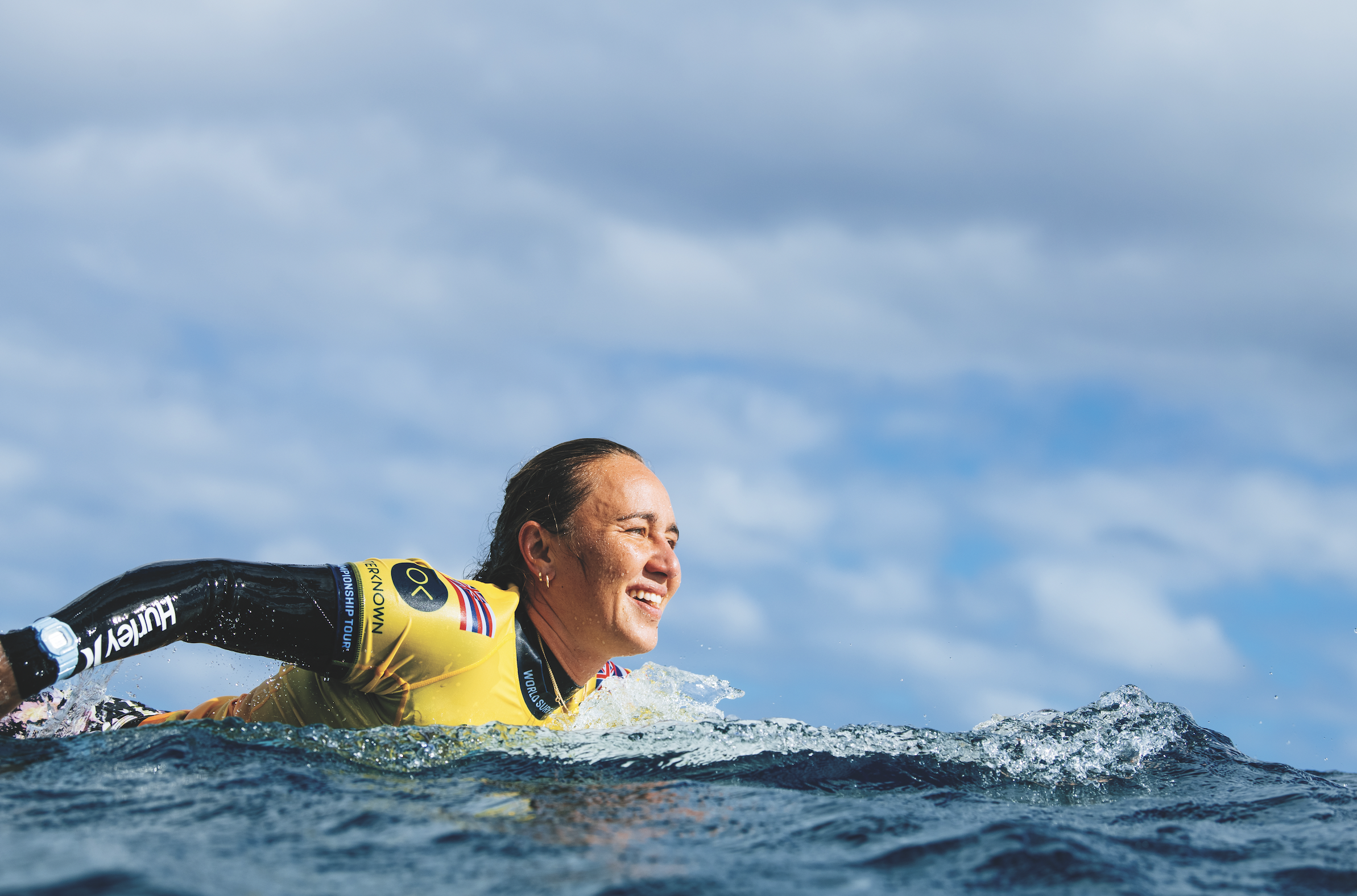
Olympic officials could have chosen a site off the coast of France, such as the surf towns of Biarritz or Hossegor, but historically, Mother Nature brings more sizable waves to Tahiti at this time of year. Plus, surfing has deep cultural ties to the region. The sport originated in Polynesia and dates as far back as the 12th century; it was practiced by Polynesian royalty. Teahupo’o is also a world-class wave that challenges the mental and physical prowess of even the most experienced competitors. The high risk of surfing this spot guarantees thrills that officials anticipate will boost viewership.
Located in the gin-clear waters of the South Pacific with a background of mountains that appear to be draped in jade-green crushed velvet, Teahupo’o (pronounced TAY-a-hoo-poh-oh) is one of the sport’s most infamous swells. (Its name loosely—and cheerily—translates to “place of skulls”.) According to Memoirs of Marau Taaroa, Last Queen of Tahiti, printed in 1893, the first person to surf it was actually a woman from the island of Raiatea, in the 19th century. Not until the 1980s did anyone dare attempt it again, with the first competition hosted in the late 1990s. Former pro turned filmmaker Chris Malloy has called it “the wave that has changed surfing forever”.

In the right conditions, Teahupo’o can tower upwards of six metres. That may sound small compared to the monster-size Jaws in Maui or Nazaré in Portugal—which can climb as high as 25 metres—but it’s not the height that makes Chopes, as the wave is lovingly called, so special. It’s the weight. When surfers describe a wave as heavy, they’re referring to its combination of a thick lip (the powerful section that starts to curl over) and the amount of water surging behind it.
Like most of the surf breaks found throughout French Polynesia, Teahupo’o is a reef break, meaning the water spills over the surface of knife- sharp coral. Chopes is unique because around 50 metres beyond the reef, the ocean drops more than 15 metres. As swells come toward the shore, the transition from deep water causes them to jack up over the coral before quickly crashing down with tremendous force.

“The reef evolved perfectly in order to absorb the wave’s energy in the shortest distance possible to create this natural wonder,” surf superstar Laird Hamilton tells Robb Report. “It’s a wave that stands straight up and creates a huge barrel. It’s one of the greatest waves on Earth.” In 2000, Hamilton rewrote surfing history when he rode what has been dubbed the Millennium Wave here. Up until then, Teahupo’o was considered too perilous to attempt when it reached a certain size. Hamilton, a pioneer of tow surfing, had a jetski pull him into what is still considered one of the heaviest waves ever ridden. Surfer magazine published a memorable cover of him getting barrelled with just the words “Oh my god…” because the feat was so dangerous.
In places, the reef lurks just 50 centimetres beneath the water’s surface, and the lip can act like a liquid guillotine if it clamps down before a surfer exits the hollow tube of the wave, known as the barrel. Had Hamilton wiped out, he wouldn’t have had an escape route.
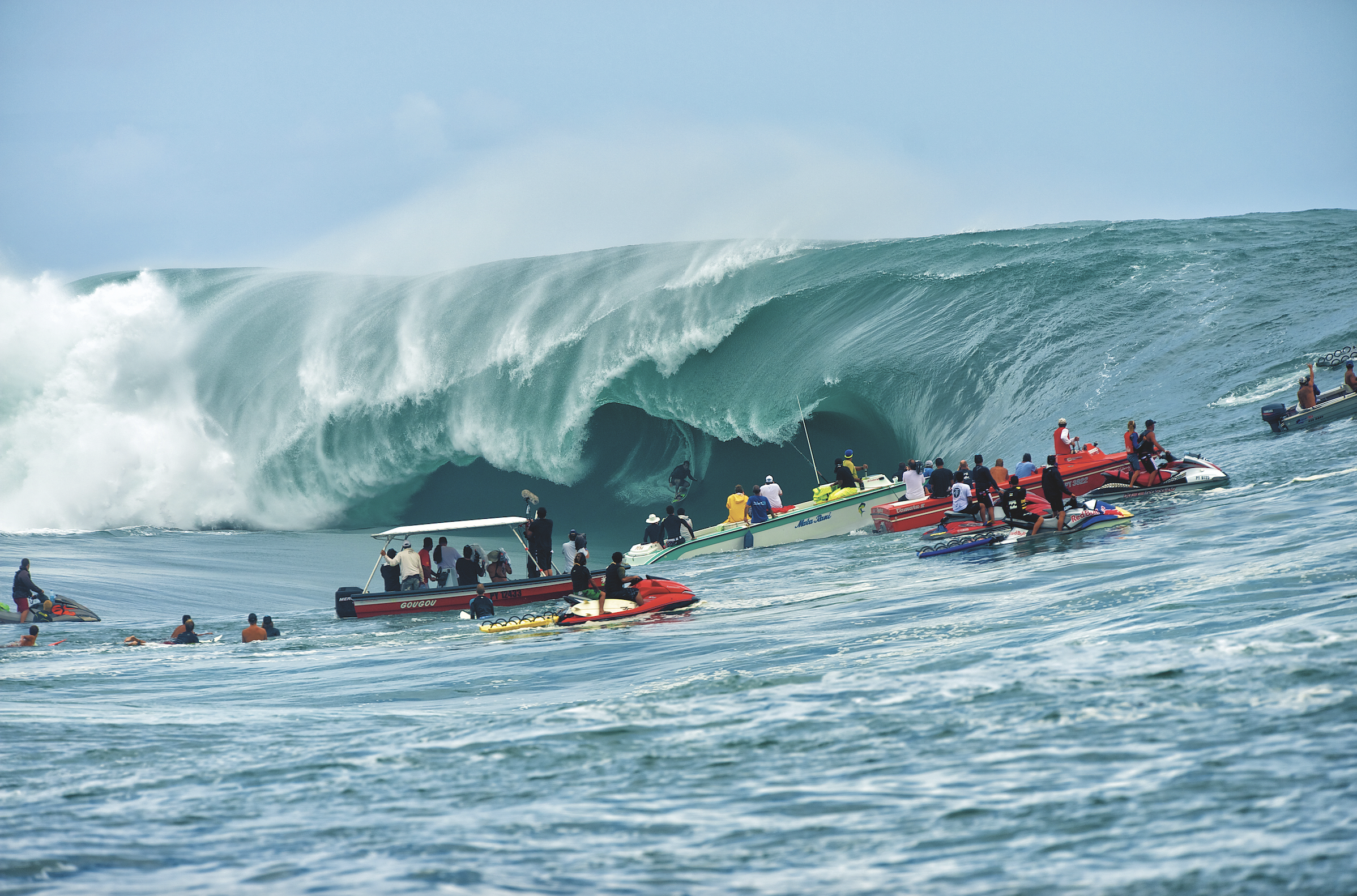
I’m an avid amateur surfer and live on Maui part-time to take advantage of Hawaii’s waves, but even on a gentle day, I wouldn’t attempt Teahupo’o. Teahupo’o village has a water-safety patrol that watches over athletes during contests. Still, a handful of surfers have lost their lives here, and many go home with serious battle wounds. In August last year, during a practice session for the Tahiti Pro, Ethan Ewing fractured two vertebrae in his back after crashing out in solid, but average, six-foot waves—an accident that arguably cost him top spot in the world rankings.
In classic gung-ho-surfer fashion, though, the Queenslander was back in the water at Teahupo’o three months later, one eye still resolutely fixed on Olympic glory. “Definitely more anxious than excited heading back to Tahiti after hitting the reef really hard last time,” he posted on his Instagram account. “Teahupo’o is still seriously intimidating, but I feel like I’ve made some steps in the right direction.”
Unless you surf, Tahiti Iti probably isn’t on your radar. Starting from the largest town of Taravao, the south-coast road ends at the village of Teahupo’o, hence its nickname, the End of the Road. The community, just 500 metres from the wave, is the antithesis of the glitz and glamour of Paris or even nearby Bora Bora. This is a slice of tropical paradise that has somehow evaded development. To reach the contest each day, I park at the end of the road, then walk over a one-lane bridge and follow a sandy path that passes local homes.
“All of your senses are heightened here,” former world surf champion C. J. Hobgood tells me when I run into him at the event. “It’s not just the wave—it’s the island. Everything looks five- dimensional. Mountains seem stacked on mountains and glow a vivid green. You turn to the right and these bluer-than-blue waves are breaking. Then a rainbow might appear in the sky. The raw beauty is overwhelming to take in when you first arrive.”
Surfers talk of feeling the mana, a Polynesian word for spiritual energy, here. Jack Robinson even referenced it after his victory in the Tahiti Pro. It may sound woo-woo, but I undoubtedly feel something when I arrive after a 90-minute drive south-west from the hotel-lined harbour of Tahiti Nui, the island’s larger, more developed area. Tahiti Iti’s empty beaches and waterfall-riddled lush interiors remind me of a quieter, more vibrant version of Hana, a little corner of Maui with just one hotel, a handful of restaurants and kilometres of untamed nature. In an era of over-tourism, this kind of purity comes with a trade-off: You won’t find five-star hotels or celebrity-chef restaurants on Tahiti Iti. In fact, it doesn’t have any hotels at all—and won’t be opening any ahead of the Games.
Locals have been adamant that Olympic infrastructure remains minimal. The proposed construction of a three-storey judging tower directly on the reef at Teahupo’o has been a major concern among residents and environmental groups. The one Olympic improvement locals welcome is a new bridge that will connect to the beach in front of Chopes.
I check into Villa Mitirapa, newly built in the rural community of Afaahiti, a 25-minute drive from Teahupo’o. Giant carved wooden doors lead to an open-air living room, a plunge pool and views of the lagoon, and every evening a chef drops by with a delicious preparation of the catch of the day. In the village of Teahupo’o, you’ll find family-owned guesthouses such as Vanira Lodge, a collection of three bungalows tucked up in Te Pari (“the cliffs” in Tahitian), as well as A Hi’o To Mou’a, a B&B run by the proprietor of hiking outfit Heeuri Explorer.

Pro surfers are typically hosted by the same local families year after year. (During the Olympics, athletes will be housed on a ship anchored in a sandy area offshore to avoid damaging the seabed.) Hobgood tells me he made visits to his “adopted Tahitian family” for nearly two decades. For the past five years, he has come to Teahupo’o to help coach reigning Olympic champ, Hawaiian Carissa Moore and now stays with her adopted family. “They take us on hikes you’d otherwise never know how to access and have rich stories about the place,” he says. “And everything they prepare for us at meals, from the passion-fruit jam to the chilli sauce, is homemade.”
The next big thing being “adopted” by a Tahitian family is hiring Raimana van Bastolaer as your guide. For a first-time visitor, Tahiti Iti can be far harder to access than other islands, which is perhaps why so few people explore the peninsula. You need a local to reveal where to go, and van Bastolaer makes you feel like an insider.
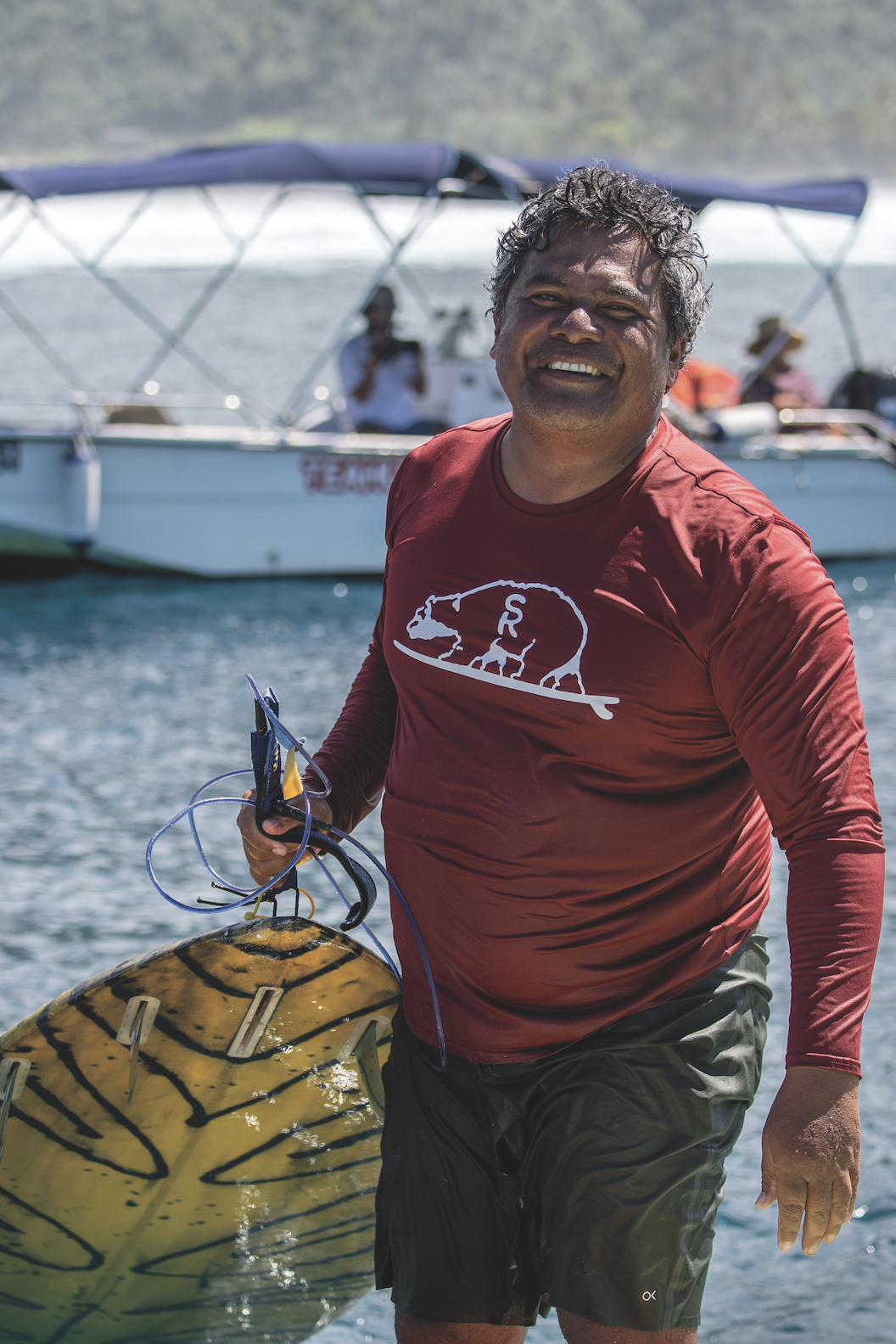
Born and raised in the capital of Papeete, he was one of the first locals to surf Chopes, and over the years, his intricate knowledge of the wave has earned him the nickname the Godfather of Teahupo’o. He was out in the channel with Hamilton the day the American had his historic ride, and John John Florence and Kelly Slater are among the surfers who stay with him when they’re in town. Van Bastolaer even did a stint as a part-time coach at Surf Ranch, Slater’s central California wave park. Thanks to his non-stop pursuit of a good time, everyone wants to be around him. Now 48, the stockily built, dauntingly athletic van Bastolaer has become the go-to guide for visitors ranging from Julia Roberts, Margot Robbie and Jason Momoa to Mark Zuckerberg and Prince Harry. “I get to yell at princes and CEOs,” he jokes. “I’m out in the water with them telling them when to pop up and paddle. And they love it.”
Tahiti’s unofficial ambassador lives and breathes surfing. Through his company, Raimana World, he takes just one or two guests at a time on private curated surf tours throughout French Polynesia’s two central archipelagoes: the Society Islands (which are home to Tahiti) and the Tuamotus; he plans to add Fiji soon. Some of his clients base themselves on their own yachts or charter one through Pelorus. The yacht specialist’s Tahiti portfolio includes the 77-metre La Datcha, which has two helipads, a submersible and a spa.

Other clients he directs to exclusive properties, such as Motu Nao Nao, a new 25-hectare private-island resort in the cerulean lagoon of Raiatea with just three enormous villas crafted from coral, wood, and shells. A roving bar bike delivers custom cocktails to guests as they explore the island, and the French chef, inspired by Asian and North African cuisine, prides himself on never repeating a dish, no matter how long guests stay.
Van Bastolaer gets only one or two clients a year experienced enough to be coached into a barrel at Teahupo’o. “Most just want to get close to the wave to feel its energy and hear it roar,” he says. “That’s enough to give you an adrenaline rush.” Locals are incredibly protective of their surf spots, and van Bastolaer stays away from popular breaks. “Out of respect, I don’t take clients out if there are more than a few people in the water. Luckily, I have access to toys that get us away from the crowds.” He island-hops by helicopter, yacht or jet boat, then transports guests to surf breaks via high-speed RIB (rigid inflatable boat) or jetski. Most days average two to three hours of surfing, and he sprinkles in other activities such as snorkeling, whale watching (July to November) and barbecues at his house.
Papara, the beautiful black-sand beach where van Bastolaer honed his skills, 45 minutes from Teahupo’o, will be turned into a fan viewing zone with jumbo screens during the Olympics. Papara is one of the most forgiving surf breaks in Tahiti, and I head here to longboard. La Plage de Maui, a simple restaurant with sandy floors, plastic chairs and lagoon vistas, becomes my daily après-surf spot. Located in West Taiarapu, 40 minutes east of Papara, with nothing but coastal road and local homes in between, this humble spot sits next to Maui Beach, one of the only white-sand beaches on the whole island. This stretch may be Tahiti Iti’s best-kept secret.
After a barefoot walk along the shore, I don’t bother to put my shoes back on before heading into the restaurant, where servers proudly sport Tahiti Pro T-shirts and posters of pros hang on the walls. At a waterfront table, I spot rainbow-hued parrotfish and Moorish idol in the glassy lagoon. I’m pretty sure I could live on a diet of local Hinano beer and poisson cru, Tahiti’s national dish of raw fish marinated in lime juice and coconut milk. My final day, I ask my waitress if she’s concerned the Olympics might overexpose this laid-back, oft-forgotten enclave. She just laughs in reply.
On the drive back to my villa, I remember what van Bastolaer told me when we were introduced a year ago: Tahiti Iti’s specialness is lost on those seeking overwater bungalows or nightlife. It’s a place you can’t know in a day. The island reveals itself to you slowly. And even when van Bastolaer is your host, he won’t give away all its secrets.
You may also like.
13/04/2024
The Boldest, Most Exciting New Timepieces From Watches & Wonders 2024
Here are the highlights from the world’s biggest watch releases of the year.
Watches & Wonders, the world’s largest watch show, is in full swing in Geneva. The highly anticipated cascade of new releases is marked by confident individual brand identities — perhaps a sign that watchmakers are done scrambling through the violent collision of restricted supply and soaring demand for high end watches. All seem to be back on solid footing.
Steady confidence is a good thing. Consider Jaeger-LeCoultre offering up traditionally styled grand complications or Vacheron Constantin revamping the classic Patrimony with smaller cases and vintage-inspired radially brushed dials. Consider TAG Heuer celebrating the 55th anniversary of the square Monaco with a skeletonized flyback confidently priced at US$183,000, or Moser similarly showing off a fascinating skeletonized tourbillon in its distinctive 40 mm Streamliner at US$86,900. IWC has leaned hard into their traditionally styled Portugieser line, including an astounding Eternal Calendar complication. We find the storied French houses of Cartier, Chanel and Hermes blurring the lines between jewelry and watchmaking with the technical prowess and artistic whimsy that originally earned these brands their exalted place in the hearts and minds of sophisticated aesthetes. Confidence abounds in 2024.
We could go on and on with examples, but the watches below will demonstrate that for 2024 the big watch brands dared to be themselves, which appears to have given them the confidence to take some seriously compelling horological risks. We have separate coverage of off-show releases and, of course, Patek and Rolex, so keep and eye out for those.
—
A. Lange Söhne Datograph Perpetual Tourbillon Honeygold Lumen
Chanel Bobbin Cuff
You may also like.
A Gucci Garden Blooms in Sydney
On a rainy Sydney night, the drinks talent from Maybe Sammy mixed with guest bartenders from Giardino 25 in Florence, for a night of liquid magic.
Since hanging out its shingle in 2022, Giardino 25, the all-day café and bar located in Gucci’s palatial, multidisciplinary space in Florence, has been a boon to stylish tipplers. Taking inspiration from one of its previous tenants (a longstanding florist), the garden-themed joint (Giardino is the Italian word for garden) serves delicious aperitivi and dangerously addictive cocktails.

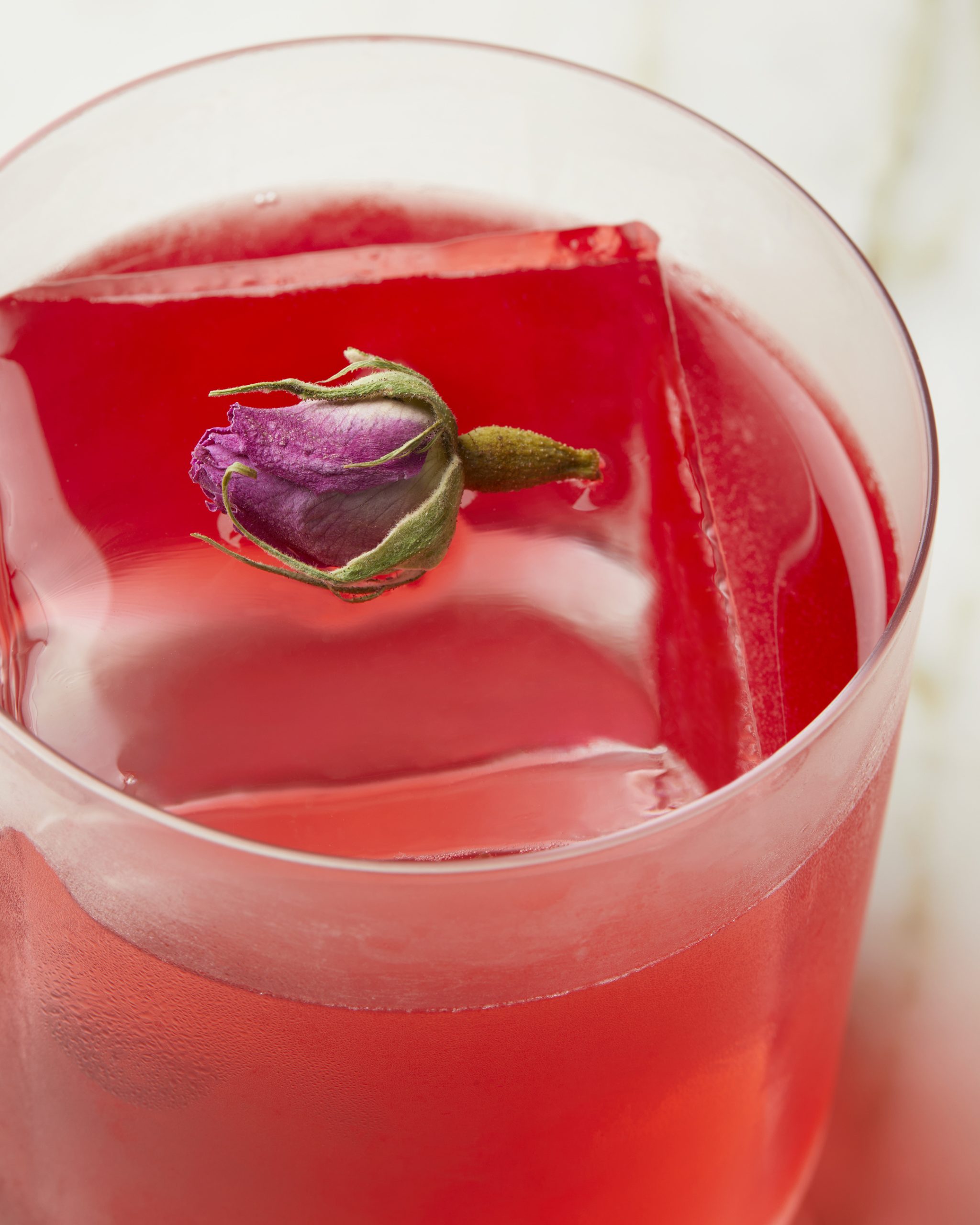
Giardino 25 took bloom this past Tuesday at a pop-up at El Primo Sanchez in Paddington. The Maybe Cocktail Festival in Sydney is a series of 20 events scattered throughout the city curated by the award-winning Sammy’s Cocktails team. The festival aims to spur knowledge-sharing and foster excellence in Australia’s drinks scene.
“Last year we held 16 events and they were all packed,” says Stefano Catino, director of hospitality at Public, the management company behind Maybe Sammy venues and bottled drinks, “so this year we’ve curated extra events and flown out even more international bars and bartenders.”
“Nineteen of the 21 events are free to attend, which is very important to us,” he continues. “The cost of living is high, and it’s very expensive for Australians to travel overseas, so this festival allows people to drink cocktails from an amazing bar in Rome or try a Tommy’s Margarita from the gentleman who created it without the cost of a plane ticket.”

Dressed head to toe in Gucci, and using the bar as her personal catwalk, Giardino 25’s special guest, Martina Bonci, looked every bit the star behind the bar. “We have brought our mix of classic Italian influences and innovation,” she told Robb Report, “so guests in Australia get a little slice of what we do in Florence.”
Among her tantalising pours were powerful dirty martinis decorated with shimmering gold leaf and Aurora, a transparent twist on the Negroni.
Reflecting on her whirlwind trip down under, Bonci said their visit to Bondi Beach and the cocktails at Maybe Sammy were the highlights.
“The bartenders at Maybe Sammy are world-class,” she explained. “There is a good reason they win awards and have a respected reputation overseas. And El Primo Sanchez has such a fun atmosphere—we had a great night.”

Bonci, who came to prominence in a long string at Milanese hipster joint Gesto and is known for her use of agave, favors drinks dripping with seasonal fruits and citrus flavors. Having tried her creations, we do, too.
She made a serious impression on Sydneysiders, who would do well to make a pilgrimage to see her in action on home turf. As if any of us need another reason to visit Italy.
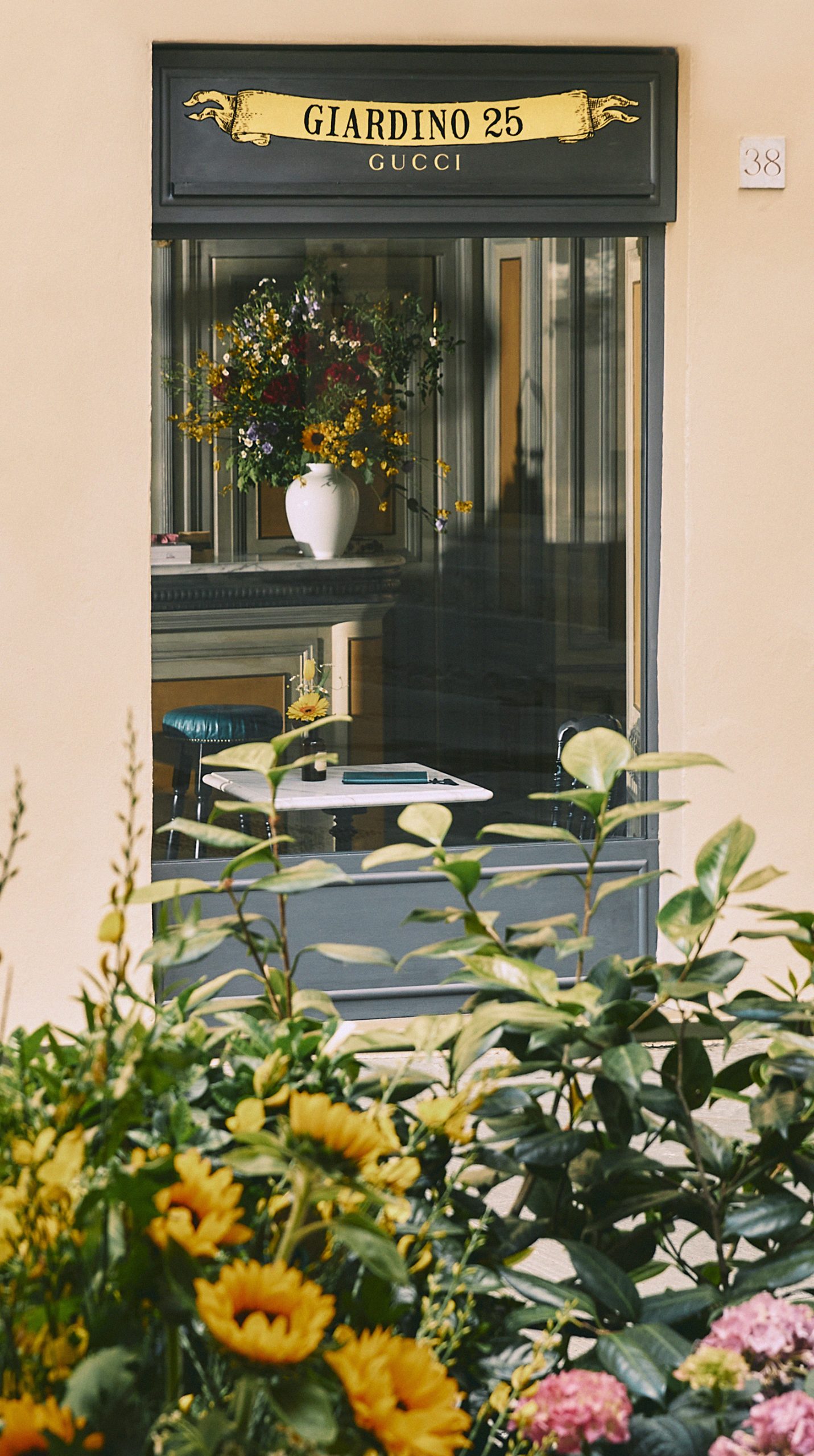
The Maybe Cocktail Festival, continues this weekend in Sydney, with the public welcome to attend a Bartenders Brunch at Sydney’s Alpha on Sunday from 11.00 am – 3.00 pm, hosted by George Calombaris.
View the program: Maybe Cocktail Festival @maybe_cocktail_fetsival

All images courtesy of Gucci.
You may also like.
Patek Philippe Brings Back Collector Favourites at Watches & Wonders 2024
Both the Nautilus Chronograph and Aquanaut Travel Time receive a welcome return.
If you’re a watch fan, there’s every reason to believe that a Patek Philippe Nautilus, Patek Philippe Aquanaut—or both—would be high on your wish list. Both collections are of historical significance, helping pave the way for the influence of the steel sports watch category—and subsequent chokehold on the market today.
So, when Patek Philippe unveiled its newest releases at Watches & Wonders in Geneva, it was a pleasant surprise to see the return of two of the best past iterations of the Nautilus and Aquanaut collections.
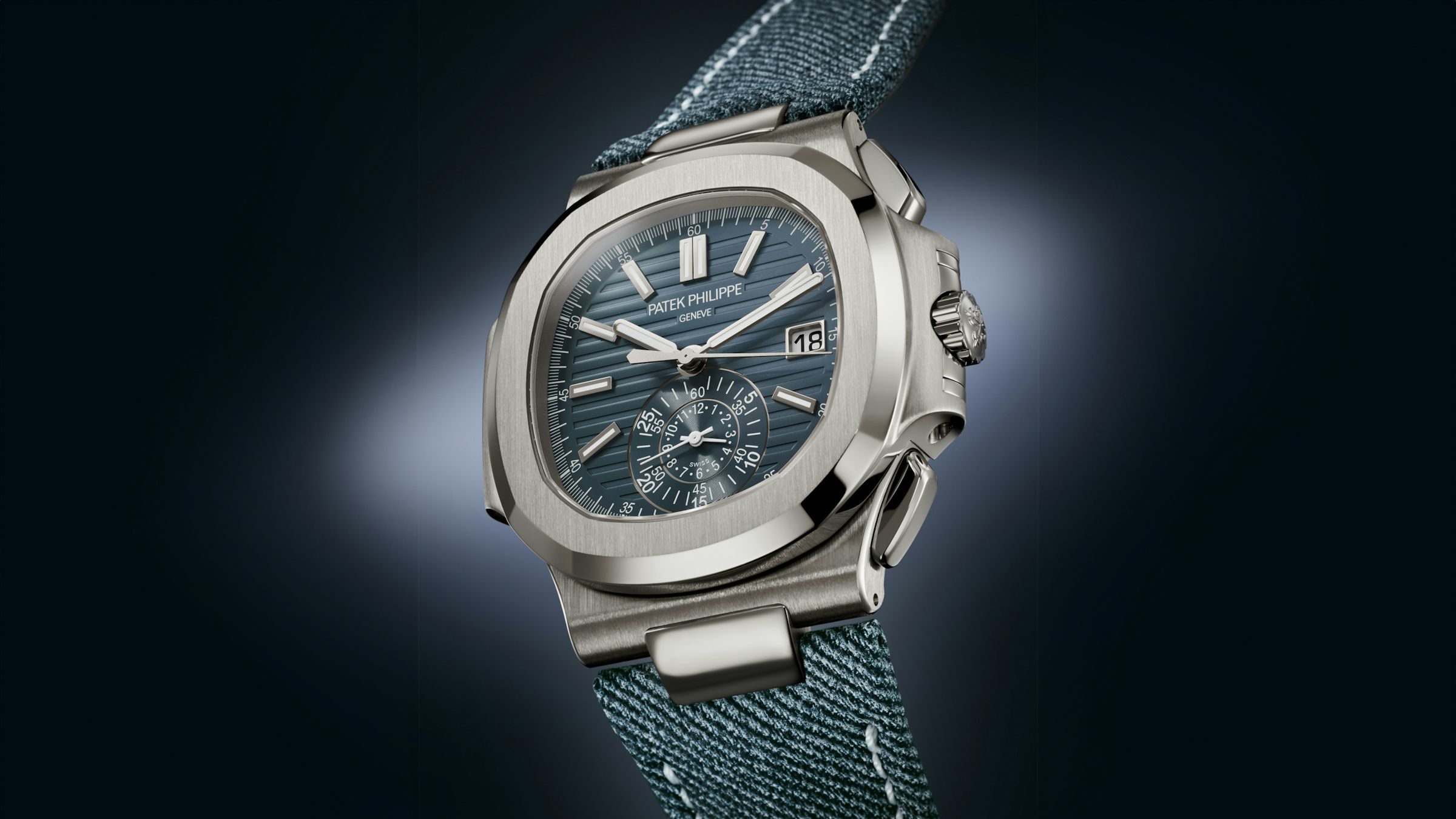
First, we get a new Nautilus Chronograph, with the return of the revered 5980, now replete with a new case in white gold and a denim-like strap (a contentious issue among watch pundits). Discontinuing all Nautilus 5980 models earlier this year, including the collector-favourite 5980/1AR in Rose Gold, left a sombre feeling among Nautilus fanatics. These celebrated chronographs, renowned for their distinctive porthole-inspired design and air of sporty elegance, are some of the most sought-after watches in the Patek Philippe catalogue. Thus, the revival of the 5980, now in white gold, is a cause for collectors’ celebration.
The new offering retains its chronograph function with mono-counter tracking 60-minute and 12-hour counter at 6 o’clock on the dial, but now comes on a new denim-inspired, hand-stitched fabric strap with a Nautilus fold-over clasp in white gold—some will love it, some won’t.

The Calibre CH 28‑520 C/522 powers this new Nautilus with its flyback chronograph, all of which is visible through the transparent sapphire crystal caseback. The dial is also incredibly eye-catching, with a beautiful opaline blue-gray hue accentuated by white gold-applied hour markers with a white luminescent coating. It is priced at approximately $112,000.
Also returning to the fold is the Patek Philippe Aquanaut Travel Time, now with its own bluish hue dial—similar to its Nautilus counterpart. After discontinuing the Aquanaut Travel Time 5164A this year, as well—a watch often regarded as the greatest Aquanaut to date—Patek Philippe surprised all with the new 5164G in white gold. Its greatest attribution is the clever Travel Time GMT function, which clearly rivals the Rolex GMT-Master II as perhaps the travel-friendly watch of choice (if acquiring one was that simple, of course).
For those who prefer the Aquanaut’s sportiness and easy-wearing rubber strap, this newest iteration, with its Opaline Blue-gray dial and matching rubber strap with a deployant clasp, is undoubtedly an icon in the making. The new 5164G has a 40mm case and features the Calibre 26‑330 S C FUS movement, which can also be viewed via the transparent sapphire crystal caseback.
Expect to pick up the new Aquanaut Travel Time for around $95,250.

—
Follow @robbreportau for all your Watches & Wonders coverage, and more!
You may also like.
13/04/2024
Rolex Kicks Off Watches & Wonders 2024 with a New GMT-Master II
The new stainless steel GMT-Master II has already been dubbed the “Bruce Wayne”.
It may not be the GMT that watch pundits were speculating on—or that collectors were hoping for—but the new Rolex GMT-Master II with a new grey and black ceramic bezel adds dazzle to the revered Rolex collection, which this year celebrates its 70th anniversary.
The idea of a new Rolex GMT launching at the world’s biggest watch fair is cause for a little madness. While the watch community eagerly awaited what was thought to be the discontinuation of the highly sought-after GMT “Pepsi” and the return of the GMT “Coke,” the luxury Swiss watchmaker had other plans.
Instead, we’re presented with a piece that, on paper, hasn’t changed much from previous GMT releases. That’s not to say that this isn’t an impressive release that will speak to consumers—the new GMT-Master II ref.126710GRNR, dubbed the “Bruce Wayne,” is definitely a sight for sore eyes.
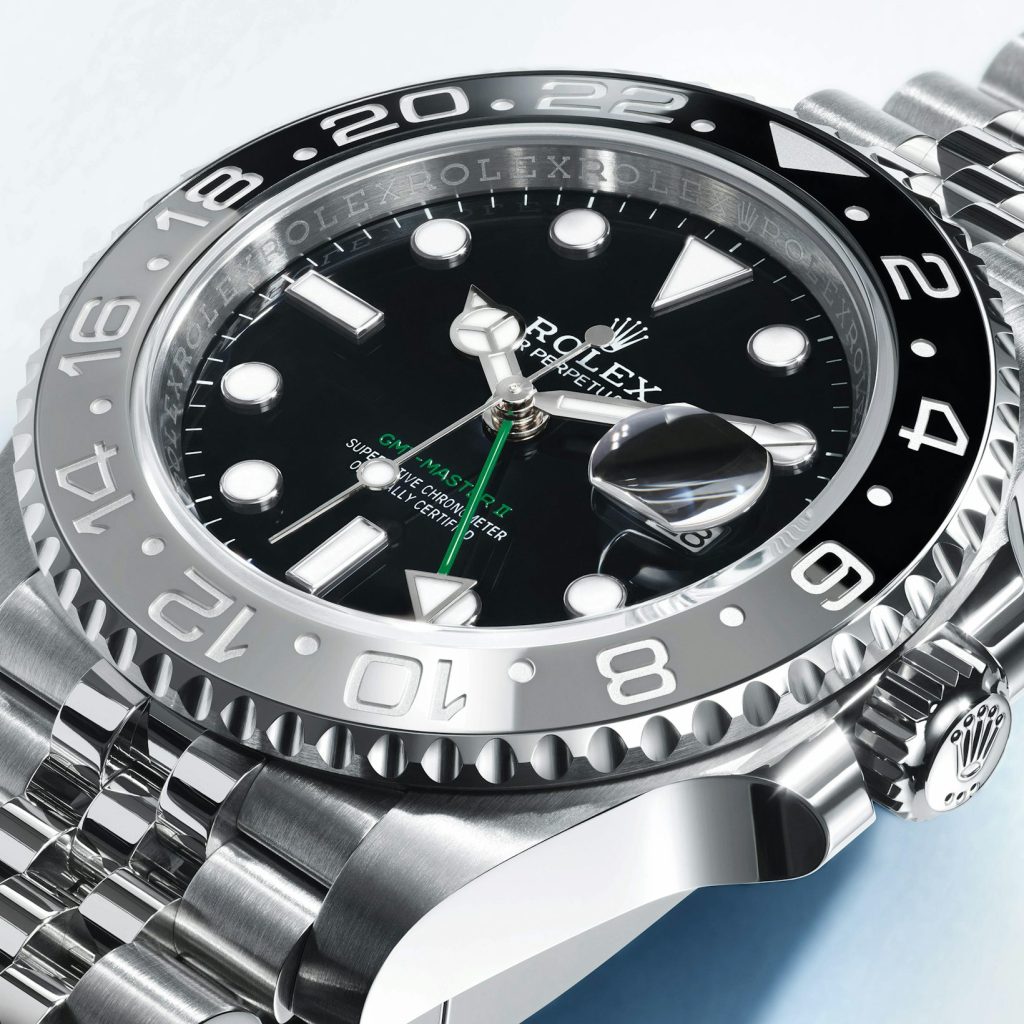
This new GMT retains the same dimensions and movement as the other watches in the GMT collection, along with its 40mm size case and the option to fit either an Oyster or Jubilee bracelet. The obvious changes, albeit subtle, come in the way of its mostly monochrome return; a fact that will appease traditionalists. If you’re opposed to the attention-drawing “Pepsi”, “Sprite”, or “Batman” iterations, this model is a stealthier pick—much like pseudonymous Bruce Wayne.
The other noticeable change is the “GMT-Master II” now applied in green text and a 24-hour hand in green; perhaps a nod to the 2007 Basel World GMT release.
Like many Rolex timepieces, this will generate great hype and attention, so don’t expect allocations to come easily.
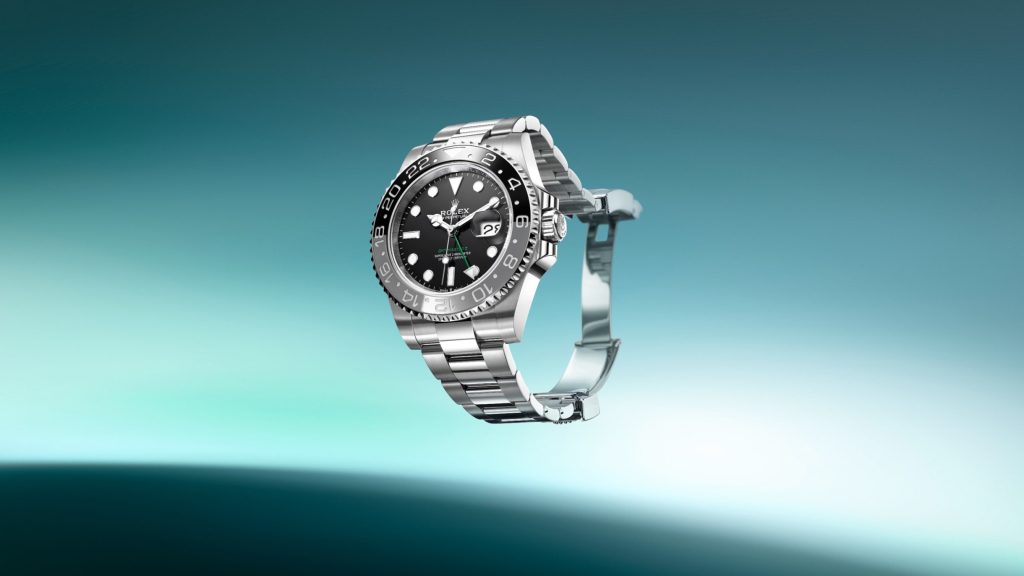
Model: GMT-Master II
Reference Number: 126710GRNR
Diameter: 40mm
Case Material: Stainless steel
Dial Colour: Black
Lume: Chromalight on hands and hour markers
Water Resistance: 100m
Bracelet: Oyster or Jubilee
Movement: Caliber 3285
Functions: Hours, minutes, seconds, date, GMT
Power Reserve: 70 hours
Winding: Automatic
Price: $17,150 (Oyster); $17,500 (Jubilee)
Availability: Now. Non-limited edition
You may also like.
13/04/2024







